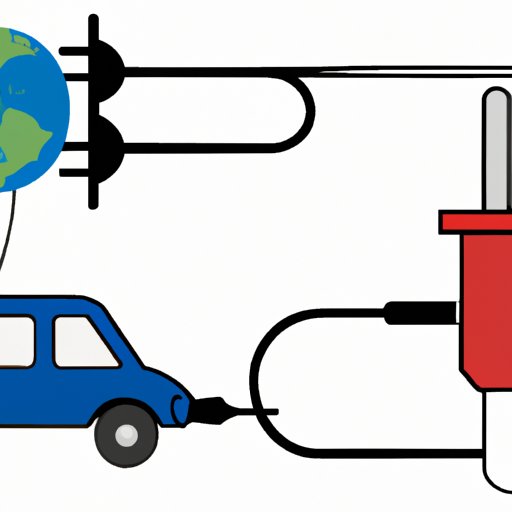Exploring the Fundamentals of Energy in Science
Energy is a fundamental concept in science that is crucial for understanding the behavior and nature of the universe. It is the driving force behind all physical and chemical processes and can be defined as the ability to do work. In this article, we will explore the different aspects of energy in science, including its basic principles, different forms, role in natural processes, and connection to the environment. Let’s begin by discussing the fundamentals of energy in science.
Defining Energy and its Importance in Science
Energy is the capacity of a physical system to perform work, and it is one of the most fundamental concepts in science. It is a scalar quantity that can be measured and expressed in terms of joules, which is the standard unit for energy in the International System of Units (SI).
Energy is essential for understanding how the physical world works because it is involved in all natural phenomena. For instance, energy is required to move, lift, heat, and cool objects, and it is also involved in chemical reactions, biological processes, and many other activities that occur in the universe.
Understanding the Basic Principles of Energy
The basic principles of energy involve various concepts, including kinetic and potential energy, work, and power.
Kinetic and Potential Energy
Kinetic energy is the energy possessed by an object due to its motion. The higher the speed of an object, the greater its kinetic energy. On the other hand, potential energy is stored energy that an object possesses due to its position or configuration. For example, a compressed spring or a stretched rubber band both have potential energy, which can be released to do work.
Work
Work is defined as the transfer of energy that results in a change in the motion or configuration of an object. For instance, lifting a weight off the ground requires work because energy is transferred from the person’s body to the weight, resulting in an increase in its potential energy.
Power
Power is the rate at which work is done or energy is transferred, and it is measured in watts. The more work done in a given time, the higher the power output. For example, a car with a more powerful engine can accelerate faster than a car with a weaker engine because it is capable of doing more work in a given time.
Exploring the Different Forms of Energy
Energy comes in various forms, and scientists classify them based on their physical and chemical properties. Some of the common forms of energy include:
Thermal Energy
Thermal energy is the energy that is associated with the motion of particles in a substance. The higher the temperature of a substance, the greater its thermal energy.
Nuclear Energy
Nuclear energy is the energy that is released from the nucleus of an atom. It is harnessed in nuclear power plants to generate electricity.
Chemical Energy
Chemical energy is the energy that is stored in the bonds between atoms in molecules. It is released when chemical reactions occur and is used to power various processes, including metabolism in living organisms and combustion in engines.
Electrical Energy
Electrical energy is the energy that results from the movement of charged particles, such as electrons. It is used to power various devices and appliances, including computers, lights, and motors.
The Role of Energy in Natural Processes
Energy plays a critical role in many natural processes, including photosynthesis, cellular respiration, and digestion. For instance, photosynthesis, which is the process by which plants produce their own food, requires energy from sunlight to convert carbon dioxide and water into glucose and oxygen. Similarly, cellular respiration, which is the process by which living organisms extract energy from glucose, requires oxygen to break down the glucose molecules and release the stored energy.
It is important to note that energy plays a vital role in sustainability and environmental conservation. For example, many natural processes are dependent on a delicate balance of energy inputs and outputs. When this balance is disrupted due to human activity, it can lead to environmental problems such as global warming and climate change.
Energy and the Environment
Energy is closely connected to environmental issues such as climate change and resource depletion. The burning of fossil fuels, which are non-renewable energy sources, releases carbon dioxide into the atmosphere, contributing to global warming and climate change. Moreover, the overuse of non-renewable energy sources puts a strain on the planet’s resources, leading to energy scarcity and environmental degradation.
One potential solution to these problems is the use of renewable energy sources such as solar, wind, and hydroelectric power, which do not cause significant harm to the environment and can be replenished naturally. Additionally, energy conservation practices such as energy-efficient appliances and transportation can help reduce our dependency on non-renewable energy sources.
Energy in Everyday Life
Energy is involved in almost every aspect of our daily lives, from the transportation we use to the appliances we rely on in our homes. For instance, the gasoline that fuels our cars is a form of chemical energy, while the electricity that powers our lights and electronics is a form of electrical energy.
Fortunately, there are many ways that individuals can make more energy-efficient choices in their lives. For example, driving a hybrid or electric car can significantly reduce fuel consumption, while upgrading to energy-efficient appliances can save money on electricity bills. Simple actions such as turning off lights and unplugging devices when not in use can also make a big difference in reducing energy consumption.
Conclusion
Energy is a fundamental concept that has far-reaching implications in science, society, and the environment. Understanding the basic principles of energy, the different forms of energy, and its role in natural processes is crucial for individuals to make informed decisions and contribute to a sustainable future. By making conscious choices and practicing energy conservation, we can collectively work towards reducing our reliance on non-renewable energy sources and preserving our planet’s resources for future generations.
